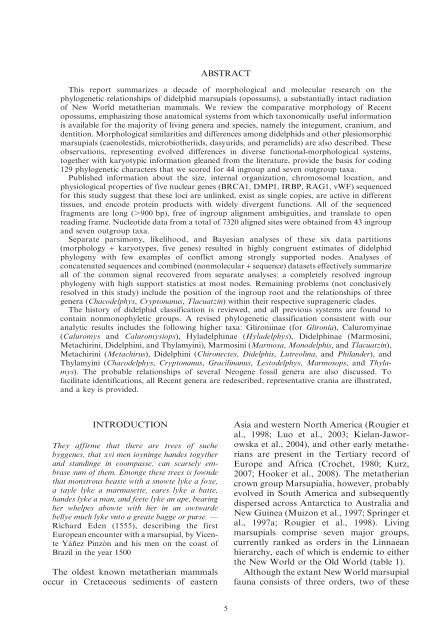phylogenetic relationships and classification of didelphid marsupials ...
phylogenetic relationships and classification of didelphid marsupials ...
phylogenetic relationships and classification of didelphid marsupials ...
You also want an ePaper? Increase the reach of your titles
YUMPU automatically turns print PDFs into web optimized ePapers that Google loves.
ABSTRACT<br />
This report summarizes a decade <strong>of</strong> morphological <strong>and</strong> molecular research on the<br />
<strong>phylogenetic</strong> <strong>relationships</strong> <strong>of</strong> <strong>didelphid</strong> <strong>marsupials</strong> (opossums), a substantially intact radiation<br />
<strong>of</strong> New World metatherian mammals. We review the comparative morphology <strong>of</strong> Recent<br />
opossums, emphasizing those anatomical systems from which taxonomically useful information<br />
is available for the majority <strong>of</strong> living genera <strong>and</strong> species, namely the integument, cranium, <strong>and</strong><br />
dentition. Morphological similarities <strong>and</strong> differences among <strong>didelphid</strong>s <strong>and</strong> other plesiomorphic<br />
<strong>marsupials</strong> (caenolestids, microbiotheriids, dasyurids, <strong>and</strong> peramelids) are also described. These<br />
observations, representing evolved differences in diverse functional-morphological systems,<br />
together with karyotypic information gleaned from the literature, provide the basis for coding<br />
129 <strong>phylogenetic</strong> characters that we scored for 44 ingroup <strong>and</strong> seven outgroup taxa.<br />
Published information about the size, internal organization, chromosomal location, <strong>and</strong><br />
physiological properties <strong>of</strong> five nuclear genes (BRCA1, DMP1, IRBP, RAG1, vWF) sequenced<br />
for this study suggest that these loci are unlinked, exist as single copies, are active in different<br />
tissues, <strong>and</strong> encode protein products with widely divergent functions. All <strong>of</strong> the sequenced<br />
fragments are long (.900 bp), free <strong>of</strong> ingroup alignment ambiguities, <strong>and</strong> translate to open<br />
reading frame. Nucleotide data from a total <strong>of</strong> 7320 aligned sites were obtained from 43 ingroup<br />
<strong>and</strong> seven outgroup taxa.<br />
Separate parsimony, likelihood, <strong>and</strong> Bayesian analyses <strong>of</strong> these six data partitions<br />
(morphology + karyotypes, five genes) resulted in highly congruent estimates <strong>of</strong> <strong>didelphid</strong><br />
phylogeny with few examples <strong>of</strong> conflict among strongly supported nodes. Analyses <strong>of</strong><br />
concatenated sequences <strong>and</strong> combined (nonmolecular + sequence) datasets effectively summarize<br />
all <strong>of</strong> the common signal recovered from separate analyses: a completely resolved ingroup<br />
phylogeny with high support statistics at most nodes. Remaining problems (not conclusively<br />
resolved in this study) include the position <strong>of</strong> the ingroup root <strong>and</strong> the <strong>relationships</strong> <strong>of</strong> three<br />
genera (Chacodelphys, Cryptonanus, Tlacuatzin) within their respective suprageneric clades.<br />
The history <strong>of</strong> <strong>didelphid</strong> <strong>classification</strong> is reviewed, <strong>and</strong> all previous systems are found to<br />
contain nonmonophyletic groups. A revised <strong>phylogenetic</strong> <strong>classification</strong> consistent with our<br />
analytic results includes the following higher taxa: Glironiinae (for Glironia), Caluromyinae<br />
(Caluromys <strong>and</strong> Caluromysiops), Hyladelphinae (Hyladelphys), Didelphinae (Marmosini,<br />
Metachirini, Didelphini, <strong>and</strong> Thylamyini), Marmosini (Marmosa, Monodelphis, <strong>and</strong>Tlacuatzin),<br />
Metachirini (Metachirus), Didelphini (Chironectes, Didelphis, Lutreolina, <strong>and</strong>Phil<strong>and</strong>er), <strong>and</strong><br />
Thylamyini (Chacodelphys, Cryptonanus, Gracilinanus, Lestodelphys, Marmosops, <strong>and</strong>Thylamys).<br />
The probable <strong>relationships</strong> <strong>of</strong> several Neogene fossil genera are also discussed. To<br />
facilitate identifications, all Recent genera are redescribed, representative crania are illustrated,<br />
<strong>and</strong> a key is provided.<br />
INTRODUCTION<br />
They affirme that there are trees <strong>of</strong> suche<br />
byggenes, that xvi men ioyninge h<strong>and</strong>es togyther<br />
<strong>and</strong> st<strong>and</strong>inge in coompasse, can scarsely embrase<br />
sum <strong>of</strong> them. Emonge these trees is fownde<br />
that monstrous beaste with a snowte lyke a foxe,<br />
a tayle lyke a marmasette, eares lyke a batte,<br />
h<strong>and</strong>es lyke a man, <strong>and</strong> feete lyke an ape, bearing<br />
her whelpes abowte with her in an owtwarde<br />
bellye much lyke vnto a greate bagge or purse. —<br />
Richard Eden (1555), describing the first<br />
European encounter with a marsupial, by Vicente<br />
Yáñez Pinzón <strong>and</strong> his men on the coast <strong>of</strong><br />
Brazil in the year 1500<br />
The oldest known metatherian mammals<br />
occur in Cretaceous sediments <strong>of</strong> eastern<br />
5<br />
Asia <strong>and</strong> western North America (Rougier et<br />
al., 1998; Luo et al., 2003; Kielan-Jaworowska<br />
et al., 2004), <strong>and</strong> other early metatherians<br />
are present in the Tertiary record <strong>of</strong><br />
Europe <strong>and</strong> Africa (Crochet, 1980; Kurz,<br />
2007; Hooker et al., 2008). The metatherian<br />
crown group Marsupialia, however, probably<br />
evolved in South America <strong>and</strong> subsequently<br />
dispersed across Antarctica to Australia <strong>and</strong><br />
New Guinea (Muizon et al., 1997; Springer et<br />
al., 1997a; Rougier et al., 1998). Living<br />
<strong>marsupials</strong> comprise seven major groups,<br />
currently ranked as orders in the Linnaean<br />
hierarchy, each <strong>of</strong> which is endemic to either<br />
the New World or the Old World (table 1).<br />
Although the extant New World marsupial<br />
fauna consists <strong>of</strong> three orders, two <strong>of</strong> these

















